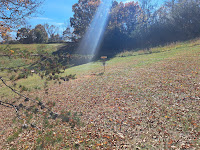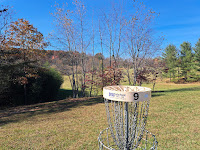Basic Information
Course Location: Mayflower Hills Park
Geographic Location: south of Roanoke, VA (37.24366, -79.87425)
Date Visited: November 2024
Number of Holes: 18
Course Length: 9240/5435 feet, par 66/65
Cost to Play: $3 park use fee
Difficulty Level: advanced from the back tee; intermediate otherwise
Difficulty Level: advanced from the back tee; intermediate otherwise
Carts: not advisable due to steep and rough terrain
Potential to Lose Discs: high due to dense woods and steep terrain
Park Information: https://www.roanokecountyparks.com/facilities/facility/details/Mayflower-Hills-Park-14
DG Course Review Page: https://www.dgcoursereview.com/courses/mayflower-hills.9737
UDisc Page: https://udisc.com/courses/mayflower-hills-EVhu
Course Walkabout Video (Front 9):
Course Walkabout Video (Back 9):
Driving Directions: On the south side of Roanoke, take I-581 to exit 6. Exit and drive east on Elm Avenue for 0.1 miles, then continue straight onto Bullitt Avenue. Drive for another 0.8 miles to 13th Street and turn right on 13th St. Drive 13th St. 0.9 miles to Riverdale Road and turn left on Riverdale Rd. Drive Riverdale Rd. 0.8 miles to Highland Drive and turn right on Highland Dr. Follow Highland Dr. for 1.9 miles to Rutrough Road and turn right on Rutrough Rd. The park entrance will be on the left in about 0.1 miles. Park in the only blacktop parking lot; #1 tee is to the west, downhill behind the picnic shelter.
Course Constructions:
Tees: 3 per hole; middle/white tees are pavers, the back/blue and front/red tees are astroturf
Baskets: Discatcher, 2 per hole, in good shape on my visit
Signage: hole sign on each white tee; course map near parking lot; some signs pointing to next tee
Amenities: practice baskets; benches on most holes; playground; picnic shelter
Summary Review: 5 Stars (out of 5)
The Mayflower Hills Disc Golf Course at Explore Park is a sprawling course that plays over the typically steep Virginia mountain terrain. The course is laid out across 2 deep and steep ravines, and the considerable elevation is used very effectively. The course has a nice mix of long and short, open and wooded holes. Overall, the course is open enough that most holes allow for a wide variety of shot shapes. The area is exclusively devoted to disc golf, and I saw few major safety hazards here. Despite the length and difficulty, I encountered quite a few not-so-skilled disc golfers on this course, so it is playable and enjoyable even if you don't score well. The course and park were popular on the pleasant Sunday afternoon that I came here. The course maintenance was flawless when I came here, but I would not want to play this course when it was wet and muddy due to the steep hillsides. While I did not score well, I did enjoy my round here, and I view Mayflower Hills as a destination disc golf course.
Hole-by-Hole Review
Distances taken from hole signs. Picture sequence for each hole is 1) white tee, 2) approach, 3) basket to tee.
Hole #1: 625/365 feet, par 4
Comments: the first 2 holes are very long and fairly open, so it's time to let 'em rip! You can't see the basket from the tee, but you want to aim for the single large tree that stands about 400 feet straight ahead: that tree is roughly on line with the basket. This hole plays moderately downhill, so the openness makes it birdie-able if you have a big enough arm. #2 tee is up the hill to the right.
Hole #2: 1090/430 feet, par 5
Comments: the longest hole on this course plays slightly downhill and then slightly uphill. It is also a gradual dogleg left, and while there are some trees on the inside of the dogleg, the woods are not dense enough to prohibit a recovery if you should miss left. A couple of trees guard the left side of the basket, so you want your approach to come in from the right. #3 tee is uphill behind the basket.
Hole #3: 425/260 feet, par 3
Comments: far more "normal" than the first 2 holes, this hole plays slightly downhill through a lightly wooded area. A left-to-right disc flight offers the widest line, but there is room to come in from the right as well. You will need to pick a line and execute a throw. #4 tee is in the woods behind the basket.
Hole #4: 355/215 feet, par 3
Comments: now the course heads into the woods, where it will stay for the next 4 holes. The line on this hole is very tight, and the right-to-left cross slope is among the steepest terrain on this course. This hole also plays downhill, so try a left-to-right disc flight to minimize the effect of the cross slope. #5 tee is downhill to the left.
Hole #5: 255/175 feet, par 3
Comments: another very tight hole, but this hole is straight enough and short enough that an accurate straight throw will set up a birdie opportunity. #6 tee is uphill to the right.
Hole #6: 425/230 feet, par 4
Comments: very short for a par 4, this is another tight hole, and it plays over a low ridge. This hole is also a slight dogleg left, so you need an accurate throw with a slight right-to-left disc flight to have a chance at birdie or maybe even eagle on this hole. #7 tee is to the left.
Hole #7: 260/140 feet, par 3
Comments: this hole plays directly across the ravine the last 3 holes have played around. The basket is to the right of the gap in the trees you can see directly across the ravine, and the hillside on which the basket is located is very steep. You will need an accurate throw or a lucky ricochet off of a tree to set-up a birdie opportunity. #8 tee is uphill behind the basket.
Hole #8: 490/265 feet, par 3
Comments: long for a par 3, this slight dogleg right has a very wide fairway and plays downhill. Due to the length, most players will have to challenge the dense woods to the right in order to get close enough to the basket in 1 throw to have a birdie opportunity. #9 tee is behind the basket.
Hole #9: 655/390 feet, par 4
Comments: a long moderately uphill hole, this hole has a wide fairway with dense woods to the right. A row of trees running perpendicular to the fairway 50 feet in front of the basket blocks direct access to the basket. Going around the trees to the right is shorter, but the gap is tighter and the dense woods to the right will need to be challenged. This is a great hole that forces you to decide how much risk you want to take with your approach throw. #10 tee is behind the basket.
Hole #10: 470/245 feet, par 3
Comments: very open and moderately downhill, a cluster of small trees stands directly in front of the basket. Throwing down the left edge of the mowed-grass fairway provides the easiest route around those small trees. #11 tee is in the light woods behind the basket.
Hole #11: 620/390 feet, par 4
Comments: a sharp dogleg right, this hole plays very downhill, so this is not as long of a par 4 as the distance would indicate. While there is a smattering of trees in the fairway, the fairway is quite wide, so you have room for a wide variety of shot shapes. The dense woods on the inside of the dogleg and behind the basket are best avoided. #12 tee is downhill to the right.
Hole #12: 620/395 feet, par 4
Comments: now here's a real par 4. The tee shot plays down into a heavily wooded ravine on a line every bit as tight as the picture above indicates. If you survive the tee shot, the approach throw is not as tight, but the stream is very much in play. 4 is a good score, especially if you play to the long/B basket. #13 tee is uphill to the left.
Hole #13: 240/190 feet, par 3
Comments: this hole plays steeply uphill back out of the ravine. There is also a steep left-to-right cross slope, and if you miss right your disc could roll a long way downhill into dense woods. I recommend a right-to-left disc flight to put your tee shot into the open area left of the basket and then try putting for birdie from there. #14 tee is uphill in the clearing behind the basket.
Hole #14: 830/530 feet, par 4
Comments: slightly downhill, super long, super open, super boring. While I appreciate this hole's simplicity, it is my least favorite hole on this course. #15 tee is in the woods to the left.
Hole #15: 320/240 feet, par 3
Comments: next we head back into the woods for the steepest downhill hole on this course. The fairway is tight but well-defined. While there is a ceiling created by tree limbs, you don't need to throw your disc nearly as far as you think due to the downhill slope. Also, you might want to check for people on the #16 tee before you throw: I was sitting on a bench there and had an errant disc whiz by my head. #16 tee is to the right.
Hole #16: 350/150 feet, par 4/3
Comments: a dogleg left that plays steeply uphill back out of the ravine. There are at least 2 possible lines of play, but both are tight and both will require a right-to-left disc flight. This hole is short for a par 4, but the tightness and uphill make 4 a reasonable par here. #17 tee is to the left.
Hole #17: 510/305 feet, par 4
Comments: this hole plays moderately uphill, and while it starts in an open field the area around the basket features a large number of small trees. A steep ravine sits just right of the basket, so don't miss right. #18 tee is down the steps to the right.
Hole #18: 700/520 feet, par 5
Comments: A local told me that some people play the back 9 first just to get this hole out of the way. While I don't know that I would recommend that approach, this is a beast of a hole no matter when you play it. The entire hole plays uphill. While the upslope is gradual at first, it gets rather steep close to the basket. The fairway is somewhat tight, and dense woods on the inside of the dogleg left frustrates any effort to cut the dogleg. More trees dot the fairway as you approach the basket. This is a memorable way to close your round on a memorable course. The parking lot is behind the basket.























































No comments:
Post a Comment